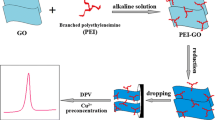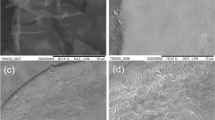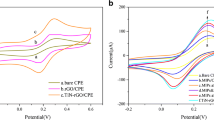Abstract
We successfully developed a GH-PP-Pt/GCE electrode by compounding graphene hydrogel (GH) with poly(3,4-ethylenedioxythiophene)-poly(styrenesulfonate) (PEDOT:PSS), and in situ electrodeposition of Pt nanoparticles. The experimental results prove that the performance of GH-PP-Pt/GCE to trace copper ions significantly improved, the sensitivity reaches 45.673 µA/µmol L−1, the limit of detection is as low as 9.9 nmol L−1, and the linear range is 0.08–10 µmol L−1. Its detection ability is at a relatively high level among the existing Cu2+ electrochemical detection sensors, and the repeatability, stability, and anti-interference are good.







Similar content being viewed by others
Data availability
All data generated or analyzed during this study are included in this published article [and its supplementary information files].
References
M. Araya, B.H. Chen, L.M. Klevay et al., Confirmation of an acute no-ob served-adverse-effect and low-observed-adverse-effect level for copper in bottled drinking water in a multi-site international study. Regul. Toxicol. Pharmacol. 38(3), 389–399 (2003)
M. Pohanka, Copper and copper nanoparticles toxicity and their impact on basic functions in the body. Bratisl Lek Listy 120(6), 397–409 (2019)
A. Sinkovic, A. Strdin, F. Svensek, Severe acute copper sulphate Poisoning: a case report. Arh Hig Rada Toksikol 59(1), 31–35 (2008)
X.B. Yin, X.P. Yan, Y. Jiang et al., On-line coupling of capillary electrophoresis to hydride generation atomic fluorescence spectrometry for arsenic speciation analysis. Anal. Chem. 74(15), 3720–3725 (2002)
J. Aggett, A.C. Aspell, Determination of Arsenic(III) and total Arsenic by atomic-absorption spectroscopy. Analyst 101(1202), 341–347 (1976)
X.P. Yan, R. Kerrich, M.J. Hendry, Determination of (ultra)trace amounts of arsenic(III) and arsenic(V) in water by inductively coupled plasma mass spectrometry coupled with flow injection on-line sorption preconcentration and separation in a knotted reactor. Anal. Chem. 70(22), 4736–4742 (1998)
M. Hossien-poor-Zaryabi, M. Chamsaz, T. Heidari et al., Application of dispersive liquid–liquid micro-extraction using mean centering of ratio spectra method for trace determination of mercury in food and environmental samples. Food. Anal. Methods 7(2), 352–359 (2014)
J.M. Gong, T. Zhou, D.D. Song et al., Stripping voltammetric detection of Mercury(II) based on a bimetallic Au-Pt inorganic–organic hybrid nanocomposite modified glassy carbon electrode. Anal. Chem. 82(2), 567–573 (2010)
E.L.S. Wong, E. Chow, J.J. Gooding, The electrochemical detection of cadmium using surface-immobilized DNA. Electrochem. Commun. 9(4), 845–849 (2007)
S.L. Ting, S.J. Ee, A. Ananthanarayanan et al., Graphene quantum dots functionalized gold nanoparticles for sensitive electrochemical detection of heavy metal ions. Electrochim. Acta 172, 7–11 (2015)
X.N. Lin, Z.W. Lu, Y.X. Zhang et al., A glassy carbon electrode modified with a bismuth film and laser etched graphene for simultaneous voltammetric sensing of cd(II) and pb(II). Microchim. Acta 185(9), 438 (2018)
E. Majid, S. Hrapovic, Y.L. Liu et al., Electrochemical determination of arsenite using a gold nanoparticle modified glassy carbon electrode and flow analysis. Anal. Chem. 78(3), 762–769 (2006)
M.R. Rahman, T. Okajima, T. Ohsaka, Selective detection of as(III) at the au(III)-like polycrystalline gold electrode. Anal. Chem. 82(22), 9169–9176 (2010)
B.K. Jena, C.R. Raj, Gold nanoelectrode ensembles for the simultaneous electrochemical detection of ultratrace arsenic, mercury, and copper. Anal. Chem. 80(13), 4836–4844 (2008)
K. Ravichandran, D.S. Vasanthi, P. Kavitha et al., Vermiwash-derived enzyme-activated ZnO nanomaterial towards two cascading applications: enhanced photocatalysis and effective irrigation. J. Mater. Sci. 32, 9584–9595 (2021)
P. Bindra, A. Hazra, Capacitive gas and vapor sensors using nanomaterials. J. Mater. Sci. 29, 6129–6148 (2018)
J.J. Gooding, J. Shein, L.M.H. Lai, Using nanoparticle aggregation to give an ultrasensitive amperometric metal ion sensor. Electrochem. Commun. 11(10), 2015–2018 (2009)
T. Wu, T. Xu, Z. Ma, Sensitive electrochemical detection of copper ions based on the copper(II) ion assisted etching of Au@Ag nanoparticles. Analyst 140(23), 8041–8047 (2015)
W.J. Li, X.Z. Yao, Z. Guo et al., Fe3O4 with novel nanoplate-stacked structure: surfactant-free hydrothermal synthesis and application in detection of heavy metal ions. J. Electroanal. Chem. 749, 75–82 (2015)
D.K. Neethipathi, A. Beniwal, A.M. Bass et al., MoS2 modified screen printed carbon electrode based flexible electrochemical sensor for detection of copper ions in water. IEEE Sens. J. 23(8), 8146–8153 (2023)
D.A.C. Brownson, C.E. Banks, Graphene electrochemistry: an overview of potential applications. Analyst 135(11), 2768–2778 (2010)
G. Williams, B. Seger, P.V. Kamat, TiO2-graphene nanocomposites. UV-assisted photocatalytic reduction of graphene oxide. Acs Nano 2(7), 1487–1491 (2008)
C. Gao, X.Y. Yu, R.X. Xu et al., AlOOH-reduced graphene oxide nanocomposites: one-pot hydrothermal synthesis and their enhanced electrochemical activity for heavy metal ions. ACS Appl. Mater. Interfaces 4(9), 4672–4682 (2012)
L. Zhang, G.Q. Shi, Preparation of highly conductive graphene hydrogels for fabricating supercapacitors with high rate Capability. J. Phys. Chem. C 115(34), 17206–17212 (2011)
X.W. Yang, J.W. Zhu, L. Qiu et al., Bioinspired effective prevention of restacking in multilayered graphene films: towards the next generation of high-performance supercapacitors. Adv. Mater. 23(25), 2833–2838 (2011)
Y.X. Xu, K.X. Sheng, C. Li et al., Self-assembled graphene hydrogel via a one-step hydrothermal process. Acs Nano 4(7), 4324–4330 (2010)
U.N. Maiti, J. Lim, K.E. Lee et al., Three-dimensional shape engineered, interfacial gelation of reduced graphene oxide for high rate, large capacity supercapacitors. Adv. Mater. 26(4), 615–619 (2014)
D. Zhao, L. Yu, D. Liu, Ultralight graphene/carbon nanotubes aerogels with compressibility and oil absorption properties. Materials 11(4), 641 (2018). https://doi.org/10.3390/ma11040641
T. Takano, H. Masunaga, A. Fujiwara et al., PEDOT nanocrystal in highly conductive PEDOT:PSS polymer films. Macromolecules 45(9), 3859–3865 (2012)
N.G. Yasri, A.J. Halabi, G. Istamboulie et al., Chronoamperometric determination of lead ions using PEDOT:PSS modified carbon electrodes. Talanta 85(5), 2528–2533 (2011)
Y.K. Kim, M.H. Kim, D.H. Min, Biocompatible reduced graphene oxide prepared by using dextran as a multifunctional reducing agent. Chem. Commun. 47(11), 3195–3197 (2011)
B. Cheng, L. Zhou, L. Lu et al., Simultaneous label-free and pretreatment-free detection of heavy metal ions in complex samples using electrodes decorated with vertically ordered silica nanochannels. Sens. Actuators B 259, 364–371 (2018)
M. Lu, Y. Deng, Y. Luo et al., Graphene aerogel-metal-organic framework-based electrochemical method for simultaneous detection of multiple heavy-metal ions. Anal. Chem. 91(1), 888–895 (2019)
S. Hao, J. Li, Y. Li et al., Facile synthesis of a 3D MnO2 nanowire/Ni foam electrode for the electrochemical detection of Cu(ii). Anal. Methods 8(24), 4919–4925 (2016)
J. Shang, M. Zhao, H. Qu et al., New application of p-n junction in electrochemical detection: the detection of heavy metal ions. J. Electroanal. Chem. 855, 113624 (2019)
Funding
This study was supported by the National Natural Science Foundation of China (11475017).
Author information
Authors and Affiliations
Contributions
Hao Changshi performed the experiment, Yan Luting contributed significantly to analysis and manuscript preparation, and Wang Yiding, Duan Shaojing, Liu Bo, and Wu Hongpeng helped perform the analysis with constructive discussions.
Corresponding authors
Ethics declarations
Competing interests
Not applicable.
Ethical approval
Not applicable.
Consent to participate
Not applicable.
Consent for publication
Not applicable.
Additional information
Publisher’s Note
Springer Nature remains neutral with regard to jurisdictional claims in published maps and institutional affiliations.
Supplementary Information
Below is the link to the electronic supplementary material.
Rights and permissions
Springer Nature or its licensor (e.g. a society or other partner) holds exclusive rights to this article under a publishing agreement with the author(s) or other rightsholder(s); author self-archiving of the accepted manuscript version of this article is solely governed by the terms of such publishing agreement and applicable law.
About this article
Cite this article
Changshi, H., Yiding, W., Hongpeng, W. et al. Trace Cu2+ detection based on GH-PEDOT:PSS-Pt NP-modified glassy carbon electrode. J Mater Sci: Mater Electron 35, 56 (2024). https://doi.org/10.1007/s10854-023-11882-w
Received:
Accepted:
Published:
DOI: https://doi.org/10.1007/s10854-023-11882-w




